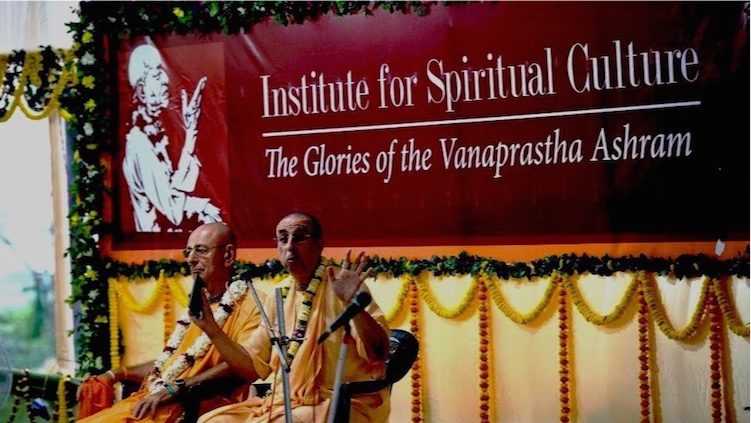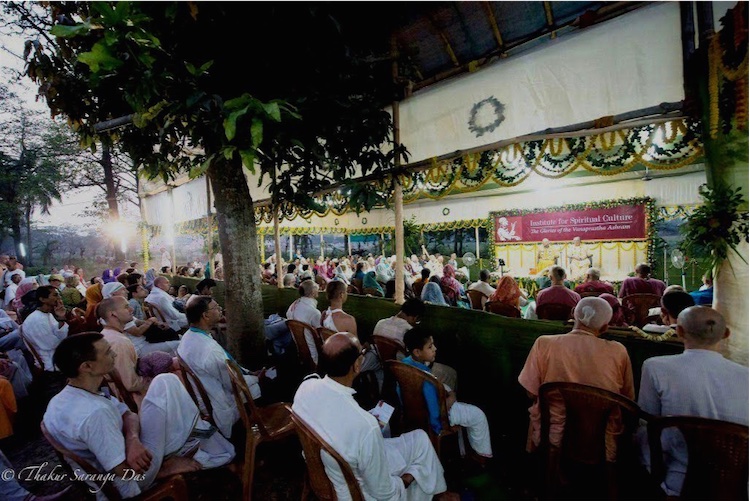Celebrating the Glories of the Vanaprastha Ashram
By Achyuta Priya Dasi | Май 21, 2016

On the 7th of March the Institute for Spiritual Culture conducted their annual program in Mayapur. This year the overall theme was “The Glories of the Vanaprastha Ashram” – a topic which attracted attention since it is not so widely discussed.
The program took place on the premises of the Old Gurukula on the way to the Goshala. A big pandal was constructed to conduct the event, and another little one with tables and chairs for the VIP prasadam – both with open sides which allowed a pleasant breeze to go through. And the nice flower decorations created a festive atmosphere. It was a perfect setting – peaceful, with green surroundings and plenty of space for devotees to move around and exchange thoughts and ideas after the program.
Around 400 devotees assembled, with many senior devotees, disciples of Srila Prabhupada and a number of sannyasis blessing the event, who were welcomed with flower garlands. Yadubara Das led the initial kirtan, followed by an opening and introduction given by Devaki Dasi. She established the purpose of the Institute for Spiritual Culture being an educational institute within the institution of ISKCON, specializing in giving systematic education and training in various aspects of spiritual culture. She briefly introduced the topic of culture coming about through the practical application of a certain world view and philosophy. Spiritual culture is Krsna’s culture, which He has given to us in order to create stability and harmony in this world. It has universal underlying principles, which are applicable anywhere in the world. All our social problems in these modern days are global reactions for not following Krsna’s system. Our disease is that we think our system is better than Krsna’s system, and we consider His system to be old-fashioned and out-dated.
She further introduced the topic of the vanaprastha ashram and it’s connection with culture. Interesting to observe how in materialistic culture where sense gratification is the ultimate goal of life old age is viewed as being the last chance to one more time enjoy life to the fullest, with luxury cruises and pleasure trips, in all comfort, leisure and opulence. In modern society old people are considered to be a burden, and thus they are pushed aside into Old Age Homes and Retirement Centers. The elderly can’t keep up the race for sense gratification and are seen to be a disturbance in the pursuits of enjoyment for the young generation.

Over 400 devotees attended the event
However, in spiritual culture where self-realization is the goal of life, the elderly are very important members of society and embody life experience, wisdom and self-realization. They are highly respected for their guidance and advice, and are passing down traditions and values to the young generation. And it is understood that this last phase of life is meant to be lived in simplicity and austerity to increase hearing and chanting, to ultimately prepare for death.
Devaki pointed out that “as long as we find it difficult to embrace spiritual culture, the vanaprastha ashram will not really manifest. And as we will be able to more and more apply and actually live our world view and philosophy, very naturally the vanaprastha ashram will gradually develop. It is a matter of systematic training and education. Therefore the Institute for Spiritual Culture had launched a new course of 15 hours on this topic of the Vanaprastha ashram, which was offered during January and was well attended and received.”
Niranjana Swami gave a short but very heart-felt talk on the importance of respect, and the valuable contribution the Vanaprasthas are meant to make: sharing their wisdom and life experience with the young generation. He was emphatically expressing how we are losing out on so much valuable wisdom of our senior householders, since the culture of giving and accepting shelter based on mutual respect between the young and senior generation has not yet been established.
Sivarama Swami gave the main speech connecting the topic of the Vanaprastha ashram with Varnashrama Dharma, explaining the importance of taking serious steps in the direction towards establishing this supportive system.
Several participants of the Vanaprastha Course were sharing realizations. Acarya Ratna Das from Poland was one of the younger students, who very eagerly took part in all courses throughout the entire month of January.
Srivasa Das and his wife from Ghana spoke next, being a very exemplary couple, both having gone through brahmacari/ni life, followed by a very active life in the grhastha ashram with lots of challenging services in various capacities, and now preparing themselves internally for the Vanaprastha ashram.
Pancaratna Das and his wife Atitaguna Dasi were also sharing thoughts and realization. They are also a very exemplary couple, having gone through the ashrams one after another, and now heading towards the Vanaprastha stage of life.
The program was concluded with kirtan lead by Bangladeshi kirtaniyas, and at the same time nice prasadam was served. There was plenty for everyone, and devotees were eagerly associating with one another over prasadam, further discussing thoughts and ideas related to the theme of the evening.
The atmosphere was very sweet, cultured and personal, and devotees were very pleased. It had certainly left impressions on devotees’ minds and had offered some food for thought – a cultured way to bring attention to the topic of spiritual culture.
* * *
The video of the entire program will soon be posted on www.therootsofspiritualculture.net















